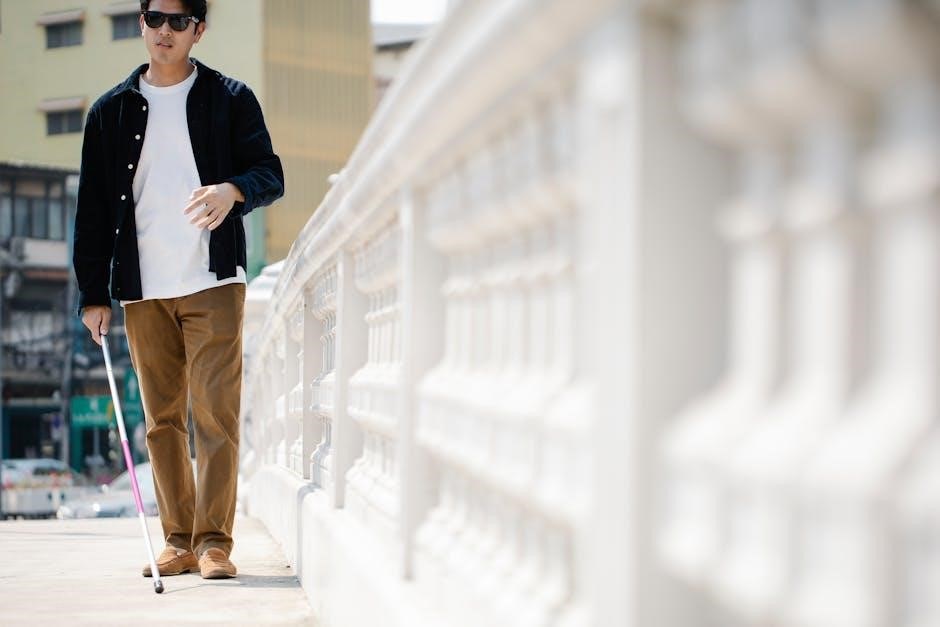Understanding jean sizing is crucial for a perfect fit. With varying measurements and styles, this guide helps you navigate size charts, ensuring comfort and confidence in your denim choices.
Understanding the Basics of Jean Sizing
Jeans sizing is based on waist and hip measurements, varying by gender and style. For women, sizes often use numerical values (e.g., 4, 6, 8), while men’s sizes are typically waist inches (e.g., 30, 32). Each size increment represents a 1-2 inch difference in waist and hip circumference. Women’s sizes may also use alphabetical labels (S, M, L). Measurements are crucial, as sizes can vary between brands due to factors like fabric stretch and cut. Understanding these basics helps navigate size charts and ensures a comfortable, flattering fit. Always measure accurately and consult brand-specific guides for the best results.
Importance of Accurate Measurements
Accurate measurements are essential for finding jeans that fit perfectly. Incorrect sizing can lead to discomfort or an unflattering appearance. To measure properly, wrap a tape around the natural waistline for women and the narrowest part of the torso for men. For hips, measure the fullest point, usually 7-9 inches below the waist. Waist and hip measurements determine the correct size; Inconsistent sizing across brands, known as vanity sizing, makes precise measurements vital. Always refer to brand-specific charts, as sizes can vary significantly. Taking the time to measure ensures a better fit, whether shopping in-store or online, and avoids the hassle of returns or alterations.

How Jean Sizes Work
Jean sizes are based on waist and inseam measurements, often represented as a numerical or S/M/L system. Sizes vary by brand and style, but standard systems guide fit consistency.
Numerical Sizing System
The numerical sizing system for jeans uses specific measurements to determine fit. For women, sizes typically range from 0 to 32, with each size corresponding to a waist and hip measurement. For example, a size 4 indicates a waist of 26-27 inches and hips of 35-36 inches. Men’s sizes are often represented as a waist/inseam combination, such as 30/32, where 30 is the waist in inches and 32 is the inseam length. This system provides a straightforward way to match your measurements to the perfect pair of jeans, ensuring both comfort and style. Variations exist between brands, so checking the specific size chart is essential.
Waist and Hip Measurements
Accurate waist and hip measurements are key to finding the perfect jeans. For women, the waist is measured at the narrowest point of the torso, while the hips are measured around the fullest part, typically 7-9 inches below the waist. Men’s measurements focus on the natural waistline, which sits just above the hip bone. These measurements determine the fit and comfort of the jeans. For instance, a woman with a 28-inch waist and 38-inch hips might fit into a size 8. Always use a flexible tape measure for precise results and refer to the brand’s size chart, as sizing can vary between brands and styles.
Size Differences Between Men’s and Women’s Jeans
Men’s and women’s jeans differ significantly in sizing and fit. Men’s jeans typically use a waist/inseam measurement system, such as 30/32, where the first number represents the waist size, and the second is the inseam length. Women’s jeans, however, often use standard numerical sizing (e.g., 4, 6, 8) or S/M/L categories, which can vary widely between brands. Women’s sizes are generally based on both waist and hip measurements, while men’s sizes focus primarily on waist size. Additionally, women’s jeans often feature more variability in fit due to factors like rise and stretch, while men’s styles tend to be more consistent. Vanity sizing also impacts women’s sizes more frequently, leading to inconsistent measurements across brands.

Measuring Yourself for Jeans
Measuring yourself for jeans requires knowing your waist, hip, and inseam. Use a tape measure to get accurate numbers for the best fit.
How to Measure Waist Size
To measure your waist size accurately, wrap a flexible tape measure around the narrowest part of your natural waistline, typically just above your belly button. Ensure the tape is level and not too tight or loose. Stand up straight and relax your stomach for the most accurate measurement; The number you get is your waist size in inches or centimeters, which corresponds to your jean size. This measurement is crucial for determining the perfect fit, as it directly affects how the jeans will sit on your body. Always double-check your measurements to ensure accuracy and a comfortable fit.
How to Measure Hip Size
To accurately measure your hip size, stand straight and locate the widest part of your hips, typically 7-9 inches below your waistline. Use a flexible tape measure and wrap it around this area, ensuring it’s snug but not tight. Keep the tape level and parallel to the floor. Measure over your underwear for the most accurate fit. Consider whether you prefer a loose or tight fit and check for brand-specific sizing variations. For stretch jeans, you may opt for a smaller size due to their flexibility. This measurement, combined with your waist size, will help determine your ideal jean size for a comfortable and flattering fit.
How to Measure Inseam Length
To measure the inseam length, remove any shoes and stand upright. Place the measuring tape along the inside of your leg, starting from the base of your crotch (where your thigh meets your pelvis) and extending down to your ankle bone or desired pant length. Ensure the tape is straight and snug against your skin for an accurate reading. This measurement determines the length of your jeans, with standard options including short (30″), regular (32″), and long (34″) inseams. For non-stretch jeans, consider your activity level and comfort preferences when choosing the length. This step is crucial for ensuring your jeans fit perfectly without dragging or being too short.
Men’s Jean Size Chart
Mens jean sizes vary by waist and inseam. Standard sizes range from 28-50, with options for big and tall. Use measurements for accurate fits across styles and brands.
Standard Sizing for Men’s Jeans
Standard sizing for men’s jeans is based on waist and inseam measurements. Waist sizes typically range from 28 to 42 inches, while inseam lengths vary from 30 to 34 inches, categorized as short, regular, or long. Each size combines these measurements, such as 32/34, indicating a 32-inch waist and 34-inch inseam. This system allows for a precise fit, accommodating different body types and preferences. However, sizes can vary between brands due to factors like fabric stretch and cut style. Always refer to the specific brand’s size chart for the most accurate fit, ensuring comfort and style.
Big and Tall Men’s Jeans Sizing
Big and tall men’s jeans sizing caters to larger waist sizes and longer inseams, offering a comfortable fit for broader frames. Waist sizes typically range from 42 to 60 inches, while inseams vary from 34 to 38 inches, accommodating taller individuals. These sizes often feature a relaxed cut through the thigh and seat for added comfort. Styles include bootcut, straight, and loose fits, providing options for different preferences. Some brands offer tailored fits to ensure a balanced look. Always check the brand’s size chart, as measurements can vary, ensuring the best fit for both style and comfort.

Women’s Jean Size Chart
Women’s jean sizes vary by waist and hip measurements, offering standard and plus-size options. Use detailed charts to find your perfect fit, ensuring comfort and style with accurate sizing. Authenticity ensured using online sources.
Standard Sizing for Women’s Jeans
Standard sizing for women’s jeans typically ranges from size 0 to 30, with measurements based on waist and hip circumference. A size 4, for example, corresponds to a 26-27″ waist and 35-36″ hips. These sizes are designed to fit a variety of body types, offering a balanced fit. However, vanity sizing can cause variations between brands, so measuring yourself and consulting the specific brand’s size chart is essential for accuracy. fabric types, such as stretch denim, may also affect fit, making some sizes feel looser or tighter depending on the material. Always check measurements for the best fit.
Plus-Size Women’s Jeans Sizing
Plus-size women’s jeans sizing typically ranges from size 14 to 30, offering a more inclusive fit for curvier figures. These sizes are designed to accommodate larger waist and hip measurements, ensuring comfort and style. Many brands now offer extended size ranges, catering to diverse body types. However, sizing can vary significantly between brands due to differences in cut and fabric. Stretch denim is particularly popular in plus sizes, providing flexibility and a flattering fit. When shopping, it’s crucial to refer to the brand’s specific size chart, as vanity sizing can lead to inconsistencies. Proper measurements and fabric considerations are key to finding the perfect pair of plus-size jeans.
International Jean Size Conversions
International jean sizes vary, with US, UK, and EU standards differing. Use conversion charts to align measurements, ensuring accurate fits across global brands and styles.
US to UK Jean Size Conversion
Converting US jean sizes to UK sizes requires understanding the numerical differences. For women, a US size 4 corresponds to a UK size 8, while a US size 6 matches a UK size 10. Men’s sizes differ slightly, with a US waist size of 30 inches equating to a UK size 30. However, variations exist due to vanity sizing and brand-specific fits. Always refer to the brand’s size chart for accuracy. For example, a US size 28 in women’s jeans converts to a UK size 10, ensuring a consistent fit across international brands.
US to EU Jean Size Conversion
Converting US jean sizes to EU sizes involves aligning numerical measurements. For women, a US size 4 translates to an EU size 32, while a US size 6 corresponds to an EU size 34. Men’s sizes follow a similar pattern, with a US waist size of 30 inches matching an EU size 30. However, variations exist due to differences in sizing standards and brand-specific fits. It’s essential to consult the brand’s size chart for precise conversions. For instance, a US size 28 in women’s jeans converts to an EU size 28, ensuring consistency across international brands and styles. This guide helps you find the perfect fit effortlessly.
Factors Affecting Jean Fit
Jean fit is influenced by fabric type, stretch, rise, and cut. Stretch denim offers comfort, while high-rise styles provide coverage. These factors ensure a tailored yet comfortable experience.
Fabric Type and Stretch
Fabric Type and Stretch
Fabric type and stretch significantly impact jean fit. Denim with elastane (1-3%) offers flexibility, conforming to the body while retaining shape. Pure cotton jeans are rigid and non-stretching, providing a classic fit. The choice between stretch and non-stretch fabrics depends on desired comfort and style. Stretch jeans are ideal for active lifestyles, while 100% cotton jeans suit those preferring a traditional feel. Understanding fabric composition helps in selecting jeans that balance comfort and aesthetics, ensuring a flattering and functional fit. Always consider fabric type and stretch when choosing jeans to meet your lifestyle needs. Proper fabric selection enhances both comfort and style.
Rise and Cut of Jeans
The rise and cut of jeans significantly influence fit and style. High-rise jeans sit above the natural waist, offering a retro look and more coverage. Mid-rise jeans are versatile, sitting at the waistline, while low-rise styles are trendy, sitting below it. The cut determines leg shape: skinny, slim, straight, or bootcut. Skinny jeans hug the legs tightly, while bootcut styles flare slightly at the bottom. Fabric stretch affects how these cuts fit, with stretch denim molding to the body. Choosing the right rise and cut balances comfort, aesthetics, and personal style, ensuring jeans flatter various body types and preferences. Proper fit enhances confidence and comfort.
Selecting the right jean style involves considering body type, lifestyle, and personal preference. High-waisted for curves, slim-fit for lean builds, and loose-fit for comfort, ensuring a flattering fit. From skinny to straight-leg, bootcut to boyfriend, jean styles vary widely. Skinny jeans hug the legs tightly, while straight-leg offers a classic fit. Bootcut flares slightly at the ankle, balancing proportions. Boyfriend and relaxed styles provide a loose, casual look. High-waisted jeans emphasize comfort and coverage, perfect for curvier figures. Low-rise styles offer a trendy, modern appeal. Each style caters to different body types and preferences, ensuring there’s a pair for everyone. Understanding these styles helps in making informed choices, enhancing both comfort and confidence. Matching jeans to your body type ensures a flattering fit. For pear-shaped bodies, high-waisted or bootcut jeans balance hips and thighs, while straight-leg styles elongate legs. Hourglass figures benefit from high-waisted, curve-hugging jeans that accentuate the waist. Petite frames look best in high-waisted, cropped, or skinny styles to create length. For rectangular body types, boyfriend or relaxed-fit jeans add shape. Apple-shaped individuals should opt for mid or high-rise styles with stretch for comfort and definition. Understanding your body type and choosing the right jean style enhances your silhouette, boosting confidence and style. Vanity sizing alters sizes to make consumers feel slimmer, causing inconsistency across brands. This practice complicates finding the right fit, as sizes vary widely despite similar measurements. Vanity sizing refers to the practice where clothing brands adjust size labels to make consumers feel thinner or more fashionable. This means a size 6 in one brand might fit like a size 8 in another. The primary goal is to boost customer satisfaction by offering smaller sizes, even if measurements remain consistent. For instance, a pair of jeans labeled as size 4 might actually fit someone with a 26-27 inch waist, which traditionally corresponds to a larger size. This inconsistency makes it challenging for shoppers to rely solely on size labels, emphasizing the need for precise measurements and brand-specific guides. Vanity sizing can lead to inconsistent fits, making it difficult to determine the correct size. Because sizes vary between brands, a smaller label might not always mean a better fit. For example, a size 6 in one brand could be equivalent to a size 8 in another, causing confusion for consumers. This discrepancy often results in ill-fitting jeans that are either too tight or too loose. To combat this, shoppers should rely on specific measurements rather than relying solely on size labels. Additionally, understanding fabric stretch and style differences is crucial for achieving the perfect fit despite vanity sizing challenges. Levi’s, Silver Jeans, and Tommy Hilfiger offer tailored size charts, ensuring precise fits. Each brand’s unique measurements and styles differ, requiring individual consultations for accurate sizing; Levi’s offers a comprehensive sizing guide, ensuring a perfect fit for all body types. Their charts include waist, hip, and inseam measurements, catering to both men and women. Levi’s uses a numerical sizing system, with sizes like 28, 30, and 32, corresponding to specific waist measurements. They also provide detailed fit descriptions, such as “Slim Fit” or “Relaxed Fit,” helping customers choose the right style. Additionally, Levi’s accommodates diverse needs with plus-size and big & tall options. Their size guide emphasizes the importance of accurate measurements to ensure comfort and style. This approach makes Levi’s a trusted choice for denim enthusiasts worldwide. Popular brands like ASOS, Madewell, and American Eagle often have unique sizing systems. ASOS uses a detailed size chart with specific waist and hip measurements, while Madewell emphasizes body measurements for accuracy. American Eagle incorporates a “AE Flex” system, offering stretch options. Some brands, like Gap, focus on vanity sizing, making sizes appear smaller. Others, such as Diesel, prioritize fit styles over numerical sizes. Differences in fabric stretch, rise, and cut also affect sizing. Always consult the brand’s specific size guide, as variations in measurements and fit styles can lead to discrepancies. This ensures the best fit when shopping across multiple brands. Common issues include jeans being too tight or loose. Consider fabric stretch, rise, and waist adjustments. Consider vanity sizing and consult size charts for accurate fits, ensuring comfort and confidence. If your jeans feel too tight, it may be due to inaccurate sizing or fabric type. Vanity sizing can mislead, so always check measurements. Opt for a larger size or stretch denim for comfort. Ensure proper rise and inseam alignment with your body. Consider high-waisted styles for better fit. Adjustments like belts or alterations can help. Prioritize fabric breathability and flexibility to avoid discomfort. Remember, tight jeans can restrict movement, so finding the right balance is key for both style and comfort. Always consult brand-specific charts, as sizing varies. If tightness persists, explore relaxed fits or different styles tailored to your body type. If your jeans are too loose, they may not fit well and can look unflattering. Check if the waist size is too large or the inseam is too long. Consider a smaller size or slim-fit styles for a better fit. Ensure the rise aligns with your natural waistline. Adjustments like belts or alterations can help. Look for styles with stretch for a snug fit. If the issue persists, explore tailored fits or different styles that suit your body type. Always refer to brand-specific charts, as sizing varies. Proper fit ensures comfort and style, so finding the right balance is essential for a polished look. Finding the perfect fit in jeans requires accurate measurements, understanding size charts, and considering fabric and style. Use these insights to make informed choices and enjoy your denim experience. For the perfect fit, always measure your waist and hips accurately. Consider the rise and fabric type, as stretch denim offers more flexibility. Try jeans on if possible, and check the inseam for ideal length. Remember, sizes vary between brands due to vanity sizing, so refer to each brand’s size chart. Don’t hesitate to seek assistance from store staff or use online calculators. Prioritize comfort and confidence, ensuring your jeans complement your body type and personal style. Lastly, keep in mind that different styles may fit differently, so explore various cuts until you find your favorite.How to Choose the Right Style
Understanding Different Jean Styles
How to Match Jeans with Body Type

Vanity Sizing and Its Impact
What is Vanity Sizing?
How Vanity Sizing Affects Fit
Brand-Specific Size Guides
Levi’s Jeans Size Guide
Other Popular Brands’ Sizing Differences

Troubleshooting Jean Fit Issues
When Jeans Are Too Tight
When Jeans Are Too Loose
Final Tips for Finding the Perfect Fit

